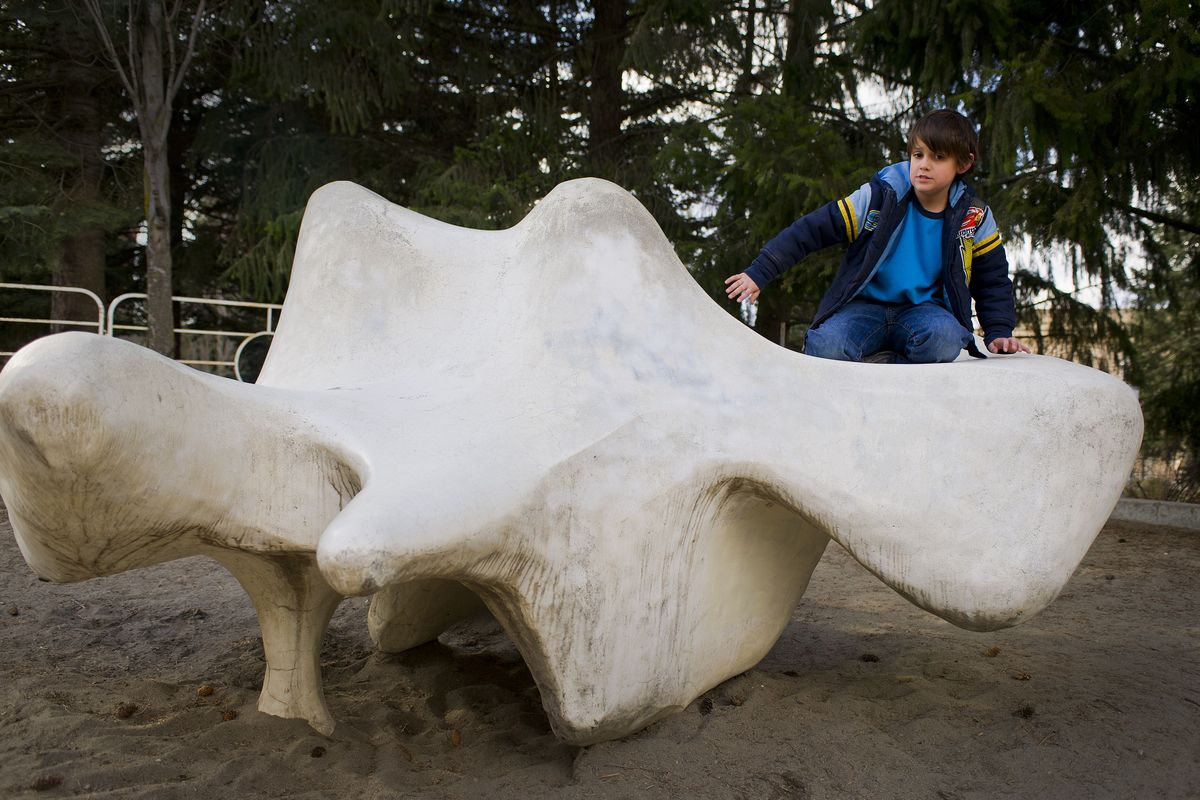City ready to toss Expo-era sculpture
Concrete artwork is worn, unsafe to play on, officials say

When noted Pacific Northwest artist Charles W. Smith was creating a sculpture in what became Riverfront Park, he was often asked what it represented.
“Nothing,” he told a Spokane Daily Chronicle reporter. “It can be anything a child wants it to be. Rather than a camel or a horse, it can be many things.”
Nearly 40 years later, Spokane arts and parks leaders, however, may give it a label: trash.
A subcommittee of the Spokane Park Board voted this week to allow the removal of the artwork, which park officials say likely will be “recycled” or thrown away. That unanimous vote followed another unanimous decision of the Spokane Arts Commission last month to let the sculpture be taken from the city’s collections. A final decision will be made by the full Park Board next week.
City officials say the unnamed sculpture, which they call “dinosaur bone,” is showing significant wear and is unsafe for kids. The piece was meant to be touched and played on, but park leaders are worried that it is not an accredited piece of play equipment.
The decision deeply concerns one of the region’s most celebrated sculptors, Harold Balazs. He said Smith was an important artist in the Northwest for whom he had deep respect. Balazs suspects the sculpture can be saved and said if the parks department no longer wants it, officials should find a new home for it.
“It’s sort of like the Taliban blowing up the 1,500-year-old statue of Buddha,” Balazs said. “Why do something like that?”
Spokane Park Director Leroy Eadie said the department’s biggest concern is safety. He said a claim was filed against the city a couple of years ago after someone fell and was injured on the sculpture. The city didn’t pay money on the claim.
Although it was meant to be played on, “there were different standards at that point in regards to safety,” Eadie said.
When told Thursday afternoon about Balazs’ concerns and other details about Smith, Eadie said he may consider asking Park Board members to delay a decision to allow for more research.
Smith, a University of Washington professor for more than 40 years and founder of the university’s industrial design program, was one of 15 sculptors chosen by a jury of artists and patrons to create work for Expo ’74 and the site that became Riverfront Park. The work was commissioned by the Spokane Junior League and originally was located on the land that covers the Washington Street tunnel. It was moved to a playground near the YMCA to make room for the Vietnam Veterans Memorial.
Spokane Arts Director Karen Mobley said concrete sculptures like Smith’s typically have a life expectancy of 30 to 40 years. While sound, it has developed several cracks.
“If we up and tried to move it one more time, it probably won’t make the move,” she said. “It’s not the most monumental work in the park.”
She added that with YMCA demolition under way, it makes sense to remove the sculpture now.
“It’s an opportunity to deal with two problems at the same time,” Mobley said. She stressed that the decision is based on the work’s condition, not on how well it is regarded as a piece of art.
Balazs questioned those who judge the piece as unimportant.
“Who’s the one who says it’s not important? I have a hard time with that,” Balazs said. “If they’re going to throw it away, I’d like them to throw it in my backyard.”
Four years ago, Seattle park leaders decided to restore a similar sculpture Smith crafted in 1961 located at the city’s Volunteer Park.
Don Latimer, owner of Artisan Finishes, Inc., led the restoration effort, which cost $8,500. After looking at pictures of cracks in Smith’s Spokane sculpture, he said it appears it could be saved.
“This is certainly in no different shape than the one we did,” he said.
When restoration was complete, Seattle held a rededication ceremony of the “historic play sculpture,” as described by a Seattle news release in 2007.
City officials say because Smith is such a common name they were uncertain if Smith was alive (he died in 2009) and struggled to find information about him.
In a letter to the Park Board, Riverfront Park Assistant Manager Debby Dodson said the sculpture was meant to be “temporary.”
But news articles from the time indicate otherwise.
“A mesh of steel, the sculpture was ready for the coat of gunite which will give a smoothed durable surface to invite climbing, exploring – whatever the child fancies – and to be lasting,” said a 1974 Chronicle story about the sculpture’s construction.
Smith’s daughter, Enid Smith Becker, an art teacher at the International School in Bellevue, Wash., said her dad’s work in Spokane sparks imaginations.
“To be able to come up and interact with a sculpture, to touch, to climb on it, to imagine the sculpture is the interior of a spaceship … that’s really necessary for kids’ healthy development,” Becker said. “If we’re talking about getting ahead in the world, the more we can encourage creativity in our children, that’s the way that we’re going to move our culture ahead and be competitive.”
Smith’s work apparently had the effect he intended. Regina Huotari, walking in the park this week with her family, remembered taking groups of children to the playground when she worked at the Y.
“Kids liked it because they thought it was a tooth,” she said.
Huotari and her mom, Shelley Ericksen, said Spokane should preserve the work because it continues to inspire creativity.
“It’s usable art forever,” Ericksen said. “We have too many things that tell you how to play with it.”